NUR1201 - Patient Experience and Partnering in Care: Reflection
VerifiedAdded on 2023/06/04
|6
|2121
|464
Essay
AI Summary
This essay reflects on Mr. Taylor's experiences in two healthcare scenarios, utilizing Gibbs' reflective model and patient satisfaction theory. It highlights the impact of waiting times on patient experience, comparing a public facility experience with that of a private doctor. The reflection emphasizes the importance of timely care, values, and beliefs in nursing practice. The analysis reveals disparities in care quality, electronic health record usage, and adherence to safety standards. The essay concludes with actionable insights for improving patient experience through family involvement, empathy, and continuous learning, stressing the need for nurses to evaluate and enhance their care quality based on patient feedback. Desklib offers similar solved assignments and resources for students.
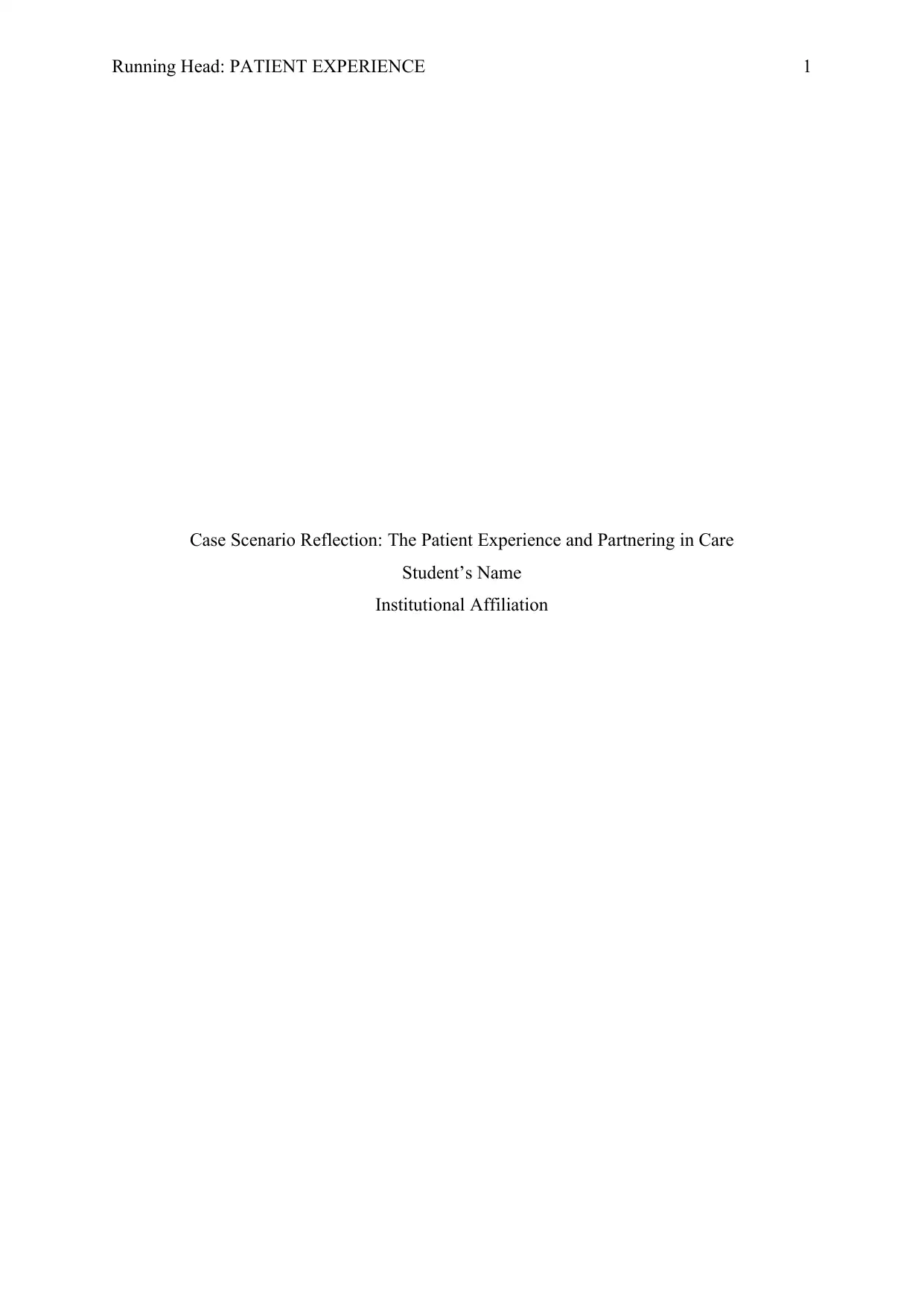
Running Head: PATIENT EXPERIENCE 1
Case Scenario Reflection: The Patient Experience and Partnering in Care
Student’s Name
Institutional Affiliation
Case Scenario Reflection: The Patient Experience and Partnering in Care
Student’s Name
Institutional Affiliation
Paraphrase This Document
Need a fresh take? Get an instant paraphrase of this document with our AI Paraphraser
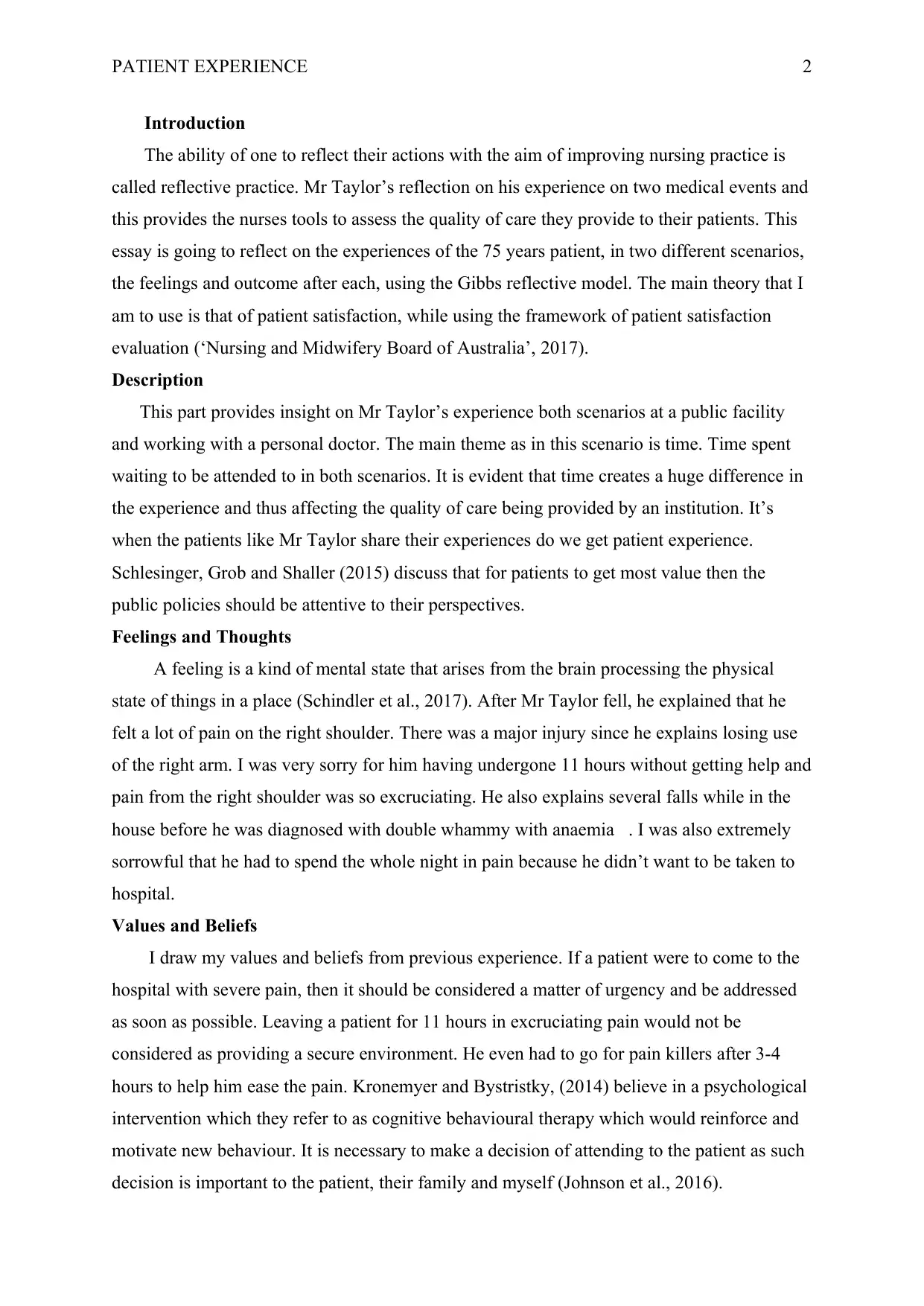
PATIENT EXPERIENCE 2
Introduction
The ability of one to reflect their actions with the aim of improving nursing practice is
called reflective practice. Mr Taylor’s reflection on his experience on two medical events and
this provides the nurses tools to assess the quality of care they provide to their patients. This
essay is going to reflect on the experiences of the 75 years patient, in two different scenarios,
the feelings and outcome after each, using the Gibbs reflective model. The main theory that I
am to use is that of patient satisfaction, while using the framework of patient satisfaction
evaluation (‘Nursing and Midwifery Board of Australia’, 2017).
Description
This part provides insight on Mr Taylor’s experience both scenarios at a public facility
and working with a personal doctor. The main theme as in this scenario is time. Time spent
waiting to be attended to in both scenarios. It is evident that time creates a huge difference in
the experience and thus affecting the quality of care being provided by an institution. It’s
when the patients like Mr Taylor share their experiences do we get patient experience.
Schlesinger, Grob and Shaller (2015) discuss that for patients to get most value then the
public policies should be attentive to their perspectives.
Feelings and Thoughts
A feeling is a kind of mental state that arises from the brain processing the physical
state of things in a place (Schindler et al., 2017). After Mr Taylor fell, he explained that he
felt a lot of pain on the right shoulder. There was a major injury since he explains losing use
of the right arm. I was very sorry for him having undergone 11 hours without getting help and
pain from the right shoulder was so excruciating. He also explains several falls while in the
house before he was diagnosed with double whammy with anaemia . I was also extremely
sorrowful that he had to spend the whole night in pain because he didn’t want to be taken to
hospital.
Values and Beliefs
I draw my values and beliefs from previous experience. If a patient were to come to the
hospital with severe pain, then it should be considered a matter of urgency and be addressed
as soon as possible. Leaving a patient for 11 hours in excruciating pain would not be
considered as providing a secure environment. He even had to go for pain killers after 3-4
hours to help him ease the pain. Kronemyer and Bystristky, (2014) believe in a psychological
intervention which they refer to as cognitive behavioural therapy which would reinforce and
motivate new behaviour. It is necessary to make a decision of attending to the patient as such
decision is important to the patient, their family and myself (Johnson et al., 2016).
Introduction
The ability of one to reflect their actions with the aim of improving nursing practice is
called reflective practice. Mr Taylor’s reflection on his experience on two medical events and
this provides the nurses tools to assess the quality of care they provide to their patients. This
essay is going to reflect on the experiences of the 75 years patient, in two different scenarios,
the feelings and outcome after each, using the Gibbs reflective model. The main theory that I
am to use is that of patient satisfaction, while using the framework of patient satisfaction
evaluation (‘Nursing and Midwifery Board of Australia’, 2017).
Description
This part provides insight on Mr Taylor’s experience both scenarios at a public facility
and working with a personal doctor. The main theme as in this scenario is time. Time spent
waiting to be attended to in both scenarios. It is evident that time creates a huge difference in
the experience and thus affecting the quality of care being provided by an institution. It’s
when the patients like Mr Taylor share their experiences do we get patient experience.
Schlesinger, Grob and Shaller (2015) discuss that for patients to get most value then the
public policies should be attentive to their perspectives.
Feelings and Thoughts
A feeling is a kind of mental state that arises from the brain processing the physical
state of things in a place (Schindler et al., 2017). After Mr Taylor fell, he explained that he
felt a lot of pain on the right shoulder. There was a major injury since he explains losing use
of the right arm. I was very sorry for him having undergone 11 hours without getting help and
pain from the right shoulder was so excruciating. He also explains several falls while in the
house before he was diagnosed with double whammy with anaemia . I was also extremely
sorrowful that he had to spend the whole night in pain because he didn’t want to be taken to
hospital.
Values and Beliefs
I draw my values and beliefs from previous experience. If a patient were to come to the
hospital with severe pain, then it should be considered a matter of urgency and be addressed
as soon as possible. Leaving a patient for 11 hours in excruciating pain would not be
considered as providing a secure environment. He even had to go for pain killers after 3-4
hours to help him ease the pain. Kronemyer and Bystristky, (2014) believe in a psychological
intervention which they refer to as cognitive behavioural therapy which would reinforce and
motivate new behaviour. It is necessary to make a decision of attending to the patient as such
decision is important to the patient, their family and myself (Johnson et al., 2016).
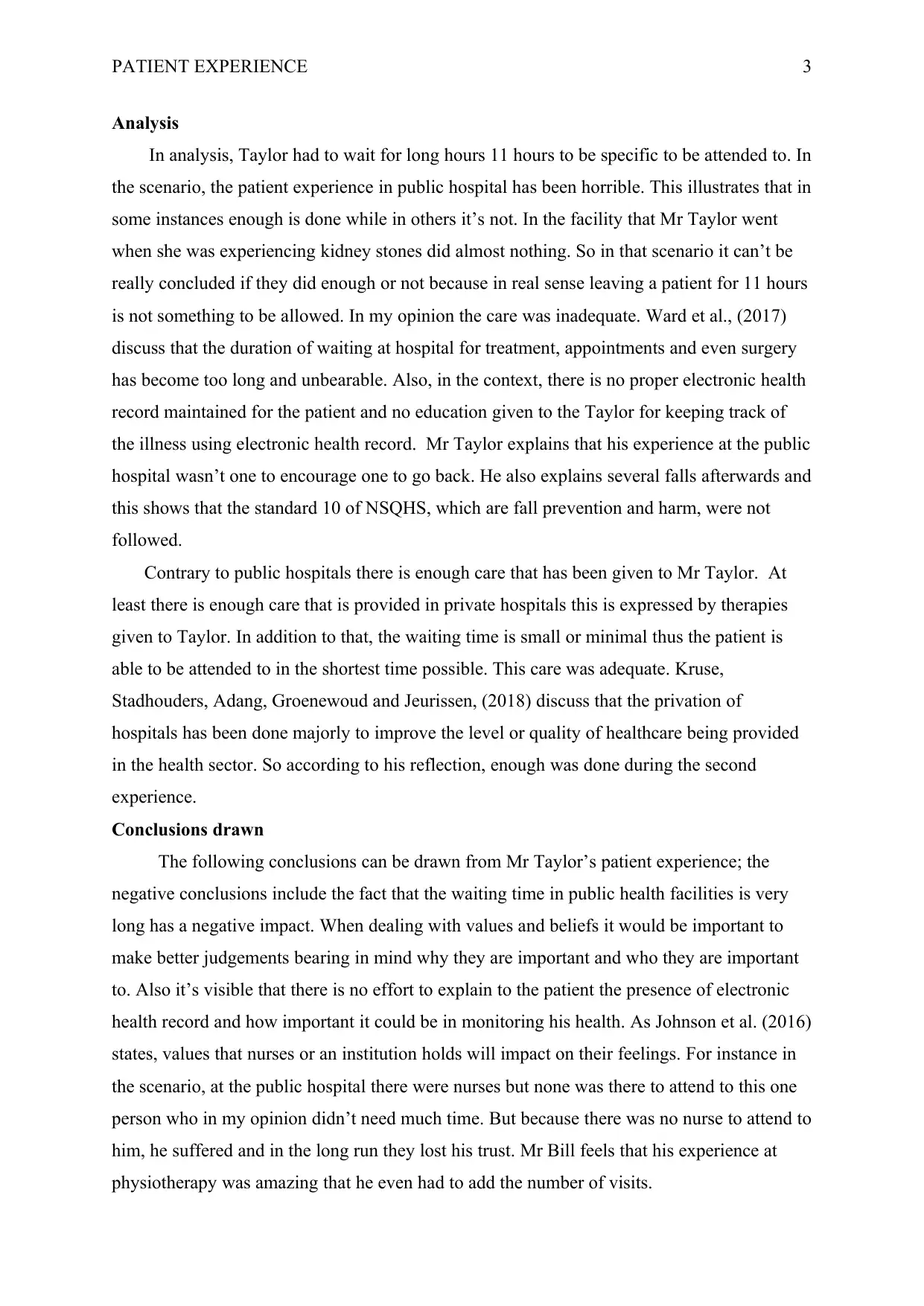
PATIENT EXPERIENCE 3
Analysis
In analysis, Taylor had to wait for long hours 11 hours to be specific to be attended to. In
the scenario, the patient experience in public hospital has been horrible. This illustrates that in
some instances enough is done while in others it’s not. In the facility that Mr Taylor went
when she was experiencing kidney stones did almost nothing. So in that scenario it can’t be
really concluded if they did enough or not because in real sense leaving a patient for 11 hours
is not something to be allowed. In my opinion the care was inadequate. Ward et al., (2017)
discuss that the duration of waiting at hospital for treatment, appointments and even surgery
has become too long and unbearable. Also, in the context, there is no proper electronic health
record maintained for the patient and no education given to the Taylor for keeping track of
the illness using electronic health record. Mr Taylor explains that his experience at the public
hospital wasn’t one to encourage one to go back. He also explains several falls afterwards and
this shows that the standard 10 of NSQHS, which are fall prevention and harm, were not
followed.
Contrary to public hospitals there is enough care that has been given to Mr Taylor. At
least there is enough care that is provided in private hospitals this is expressed by therapies
given to Taylor. In addition to that, the waiting time is small or minimal thus the patient is
able to be attended to in the shortest time possible. This care was adequate. Kruse,
Stadhouders, Adang, Groenewoud and Jeurissen, (2018) discuss that the privation of
hospitals has been done majorly to improve the level or quality of healthcare being provided
in the health sector. So according to his reflection, enough was done during the second
experience.
Conclusions drawn
The following conclusions can be drawn from Mr Taylor’s patient experience; the
negative conclusions include the fact that the waiting time in public health facilities is very
long has a negative impact. When dealing with values and beliefs it would be important to
make better judgements bearing in mind why they are important and who they are important
to. Also it’s visible that there is no effort to explain to the patient the presence of electronic
health record and how important it could be in monitoring his health. As Johnson et al. (2016)
states, values that nurses or an institution holds will impact on their feelings. For instance in
the scenario, at the public hospital there were nurses but none was there to attend to this one
person who in my opinion didn’t need much time. But because there was no nurse to attend to
him, he suffered and in the long run they lost his trust. Mr Bill feels that his experience at
physiotherapy was amazing that he even had to add the number of visits.
Analysis
In analysis, Taylor had to wait for long hours 11 hours to be specific to be attended to. In
the scenario, the patient experience in public hospital has been horrible. This illustrates that in
some instances enough is done while in others it’s not. In the facility that Mr Taylor went
when she was experiencing kidney stones did almost nothing. So in that scenario it can’t be
really concluded if they did enough or not because in real sense leaving a patient for 11 hours
is not something to be allowed. In my opinion the care was inadequate. Ward et al., (2017)
discuss that the duration of waiting at hospital for treatment, appointments and even surgery
has become too long and unbearable. Also, in the context, there is no proper electronic health
record maintained for the patient and no education given to the Taylor for keeping track of
the illness using electronic health record. Mr Taylor explains that his experience at the public
hospital wasn’t one to encourage one to go back. He also explains several falls afterwards and
this shows that the standard 10 of NSQHS, which are fall prevention and harm, were not
followed.
Contrary to public hospitals there is enough care that has been given to Mr Taylor. At
least there is enough care that is provided in private hospitals this is expressed by therapies
given to Taylor. In addition to that, the waiting time is small or minimal thus the patient is
able to be attended to in the shortest time possible. This care was adequate. Kruse,
Stadhouders, Adang, Groenewoud and Jeurissen, (2018) discuss that the privation of
hospitals has been done majorly to improve the level or quality of healthcare being provided
in the health sector. So according to his reflection, enough was done during the second
experience.
Conclusions drawn
The following conclusions can be drawn from Mr Taylor’s patient experience; the
negative conclusions include the fact that the waiting time in public health facilities is very
long has a negative impact. When dealing with values and beliefs it would be important to
make better judgements bearing in mind why they are important and who they are important
to. Also it’s visible that there is no effort to explain to the patient the presence of electronic
health record and how important it could be in monitoring his health. As Johnson et al. (2016)
states, values that nurses or an institution holds will impact on their feelings. For instance in
the scenario, at the public hospital there were nurses but none was there to attend to this one
person who in my opinion didn’t need much time. But because there was no nurse to attend to
him, he suffered and in the long run they lost his trust. Mr Bill feels that his experience at
physiotherapy was amazing that he even had to add the number of visits.
⊘ This is a preview!⊘
Do you want full access?
Subscribe today to unlock all pages.

Trusted by 1+ million students worldwide
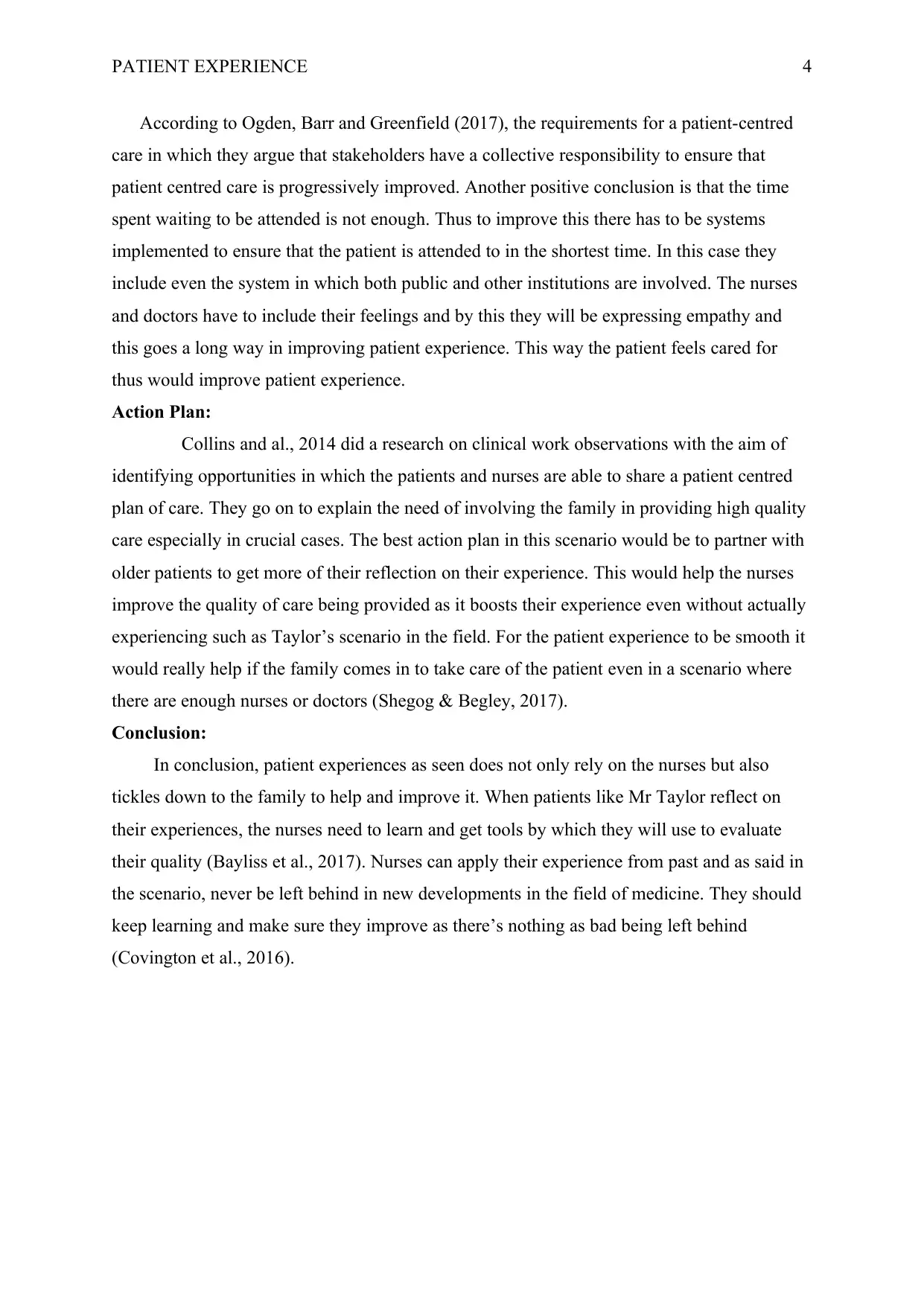
PATIENT EXPERIENCE 4
According to Ogden, Barr and Greenfield (2017), the requirements for a patient-centred
care in which they argue that stakeholders have a collective responsibility to ensure that
patient centred care is progressively improved. Another positive conclusion is that the time
spent waiting to be attended is not enough. Thus to improve this there has to be systems
implemented to ensure that the patient is attended to in the shortest time. In this case they
include even the system in which both public and other institutions are involved. The nurses
and doctors have to include their feelings and by this they will be expressing empathy and
this goes a long way in improving patient experience. This way the patient feels cared for
thus would improve patient experience.
Action Plan:
Collins and al., 2014 did a research on clinical work observations with the aim of
identifying opportunities in which the patients and nurses are able to share a patient centred
plan of care. They go on to explain the need of involving the family in providing high quality
care especially in crucial cases. The best action plan in this scenario would be to partner with
older patients to get more of their reflection on their experience. This would help the nurses
improve the quality of care being provided as it boosts their experience even without actually
experiencing such as Taylor’s scenario in the field. For the patient experience to be smooth it
would really help if the family comes in to take care of the patient even in a scenario where
there are enough nurses or doctors (Shegog & Begley, 2017).
Conclusion:
In conclusion, patient experiences as seen does not only rely on the nurses but also
tickles down to the family to help and improve it. When patients like Mr Taylor reflect on
their experiences, the nurses need to learn and get tools by which they will use to evaluate
their quality (Bayliss et al., 2017). Nurses can apply their experience from past and as said in
the scenario, never be left behind in new developments in the field of medicine. They should
keep learning and make sure they improve as there’s nothing as bad being left behind
(Covington et al., 2016).
According to Ogden, Barr and Greenfield (2017), the requirements for a patient-centred
care in which they argue that stakeholders have a collective responsibility to ensure that
patient centred care is progressively improved. Another positive conclusion is that the time
spent waiting to be attended is not enough. Thus to improve this there has to be systems
implemented to ensure that the patient is attended to in the shortest time. In this case they
include even the system in which both public and other institutions are involved. The nurses
and doctors have to include their feelings and by this they will be expressing empathy and
this goes a long way in improving patient experience. This way the patient feels cared for
thus would improve patient experience.
Action Plan:
Collins and al., 2014 did a research on clinical work observations with the aim of
identifying opportunities in which the patients and nurses are able to share a patient centred
plan of care. They go on to explain the need of involving the family in providing high quality
care especially in crucial cases. The best action plan in this scenario would be to partner with
older patients to get more of their reflection on their experience. This would help the nurses
improve the quality of care being provided as it boosts their experience even without actually
experiencing such as Taylor’s scenario in the field. For the patient experience to be smooth it
would really help if the family comes in to take care of the patient even in a scenario where
there are enough nurses or doctors (Shegog & Begley, 2017).
Conclusion:
In conclusion, patient experiences as seen does not only rely on the nurses but also
tickles down to the family to help and improve it. When patients like Mr Taylor reflect on
their experiences, the nurses need to learn and get tools by which they will use to evaluate
their quality (Bayliss et al., 2017). Nurses can apply their experience from past and as said in
the scenario, never be left behind in new developments in the field of medicine. They should
keep learning and make sure they improve as there’s nothing as bad being left behind
(Covington et al., 2016).
Paraphrase This Document
Need a fresh take? Get an instant paraphrase of this document with our AI Paraphraser
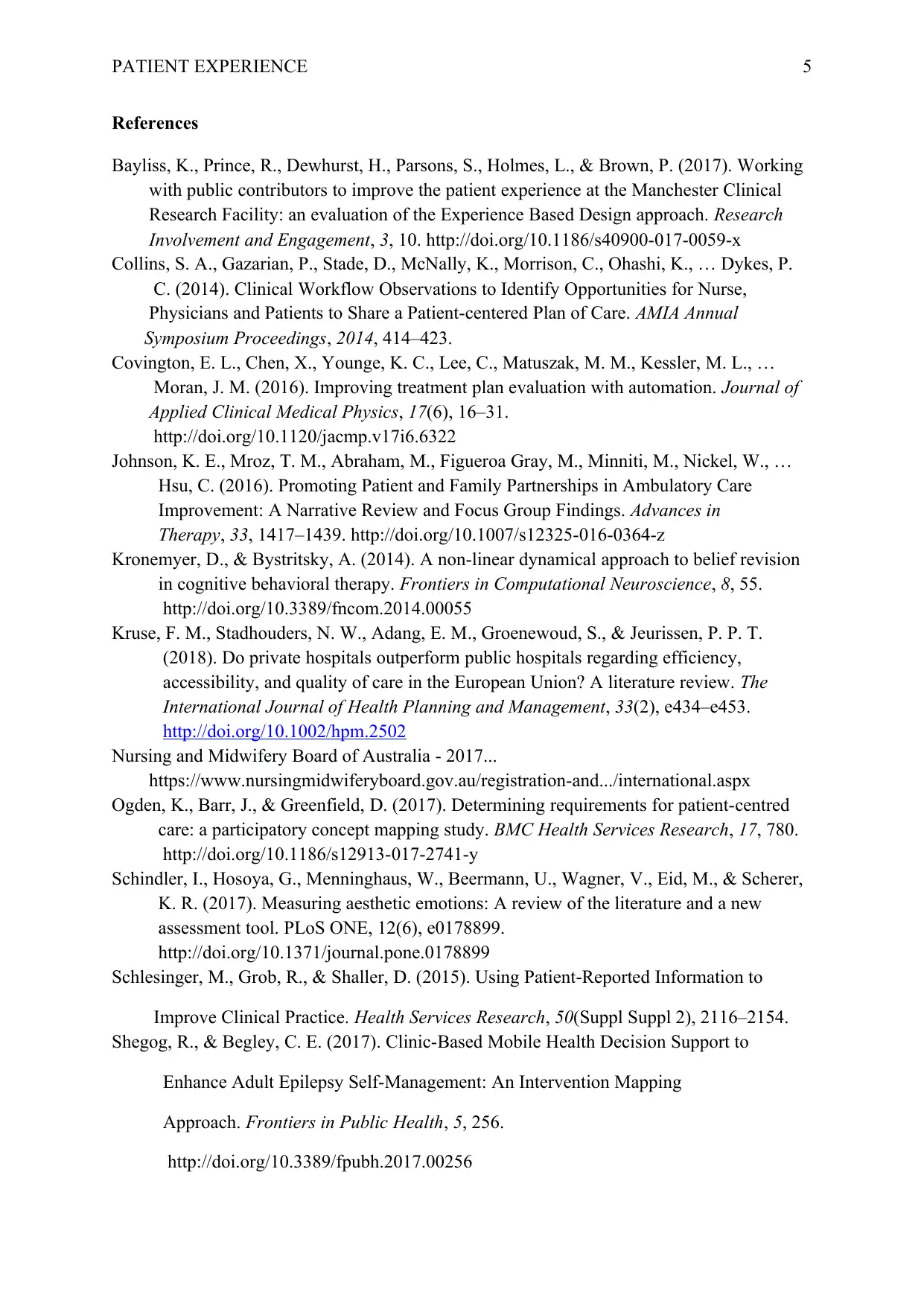
PATIENT EXPERIENCE 5
References
Bayliss, K., Prince, R., Dewhurst, H., Parsons, S., Holmes, L., & Brown, P. (2017). Working
with public contributors to improve the patient experience at the Manchester Clinical
Research Facility: an evaluation of the Experience Based Design approach. Research
Involvement and Engagement, 3, 10. http://doi.org/10.1186/s40900-017-0059-x
Collins, S. A., Gazarian, P., Stade, D., McNally, K., Morrison, C., Ohashi, K., … Dykes, P.
C. (2014). Clinical Workflow Observations to Identify Opportunities for Nurse,
Physicians and Patients to Share a Patient-centered Plan of Care. AMIA Annual
Symposium Proceedings, 2014, 414–423.
Covington, E. L., Chen, X., Younge, K. C., Lee, C., Matuszak, M. M., Kessler, M. L., …
Moran, J. M. (2016). Improving treatment plan evaluation with automation. Journal of
Applied Clinical Medical Physics, 17(6), 16–31.
http://doi.org/10.1120/jacmp.v17i6.6322
Johnson, K. E., Mroz, T. M., Abraham, M., Figueroa Gray, M., Minniti, M., Nickel, W., …
Hsu, C. (2016). Promoting Patient and Family Partnerships in Ambulatory Care
Improvement: A Narrative Review and Focus Group Findings. Advances in
Therapy, 33, 1417–1439. http://doi.org/10.1007/s12325-016-0364-z
Kronemyer, D., & Bystritsky, A. (2014). A non-linear dynamical approach to belief revision
in cognitive behavioral therapy. Frontiers in Computational Neuroscience, 8, 55.
http://doi.org/10.3389/fncom.2014.00055
Kruse, F. M., Stadhouders, N. W., Adang, E. M., Groenewoud, S., & Jeurissen, P. P. T.
(2018). Do private hospitals outperform public hospitals regarding efficiency,
accessibility, and quality of care in the European Union? A literature review. The
International Journal of Health Planning and Management, 33(2), e434–e453.
http://doi.org/10.1002/hpm.2502
Nursing and Midwifery Board of Australia - 2017...
https://www.nursingmidwiferyboard.gov.au/registration-and.../international.aspx
Ogden, K., Barr, J., & Greenfield, D. (2017). Determining requirements for patient-centred
care: a participatory concept mapping study. BMC Health Services Research, 17, 780.
http://doi.org/10.1186/s12913-017-2741-y
Schindler, I., Hosoya, G., Menninghaus, W., Beermann, U., Wagner, V., Eid, M., & Scherer,
K. R. (2017). Measuring aesthetic emotions: A review of the literature and a new
assessment tool. PLoS ONE, 12(6), e0178899.
http://doi.org/10.1371/journal.pone.0178899
Schlesinger, M., Grob, R., & Shaller, D. (2015). Using Patient Reported Information to‐
Improve Clinical Practice. Health Services Research, 50(Suppl Suppl 2), 2116–2154.
Shegog, R., & Begley, C. E. (2017). Clinic-Based Mobile Health Decision Support to
Enhance Adult Epilepsy Self-Management: An Intervention Mapping
Approach. Frontiers in Public Health, 5, 256.
http://doi.org/10.3389/fpubh.2017.00256
References
Bayliss, K., Prince, R., Dewhurst, H., Parsons, S., Holmes, L., & Brown, P. (2017). Working
with public contributors to improve the patient experience at the Manchester Clinical
Research Facility: an evaluation of the Experience Based Design approach. Research
Involvement and Engagement, 3, 10. http://doi.org/10.1186/s40900-017-0059-x
Collins, S. A., Gazarian, P., Stade, D., McNally, K., Morrison, C., Ohashi, K., … Dykes, P.
C. (2014). Clinical Workflow Observations to Identify Opportunities for Nurse,
Physicians and Patients to Share a Patient-centered Plan of Care. AMIA Annual
Symposium Proceedings, 2014, 414–423.
Covington, E. L., Chen, X., Younge, K. C., Lee, C., Matuszak, M. M., Kessler, M. L., …
Moran, J. M. (2016). Improving treatment plan evaluation with automation. Journal of
Applied Clinical Medical Physics, 17(6), 16–31.
http://doi.org/10.1120/jacmp.v17i6.6322
Johnson, K. E., Mroz, T. M., Abraham, M., Figueroa Gray, M., Minniti, M., Nickel, W., …
Hsu, C. (2016). Promoting Patient and Family Partnerships in Ambulatory Care
Improvement: A Narrative Review and Focus Group Findings. Advances in
Therapy, 33, 1417–1439. http://doi.org/10.1007/s12325-016-0364-z
Kronemyer, D., & Bystritsky, A. (2014). A non-linear dynamical approach to belief revision
in cognitive behavioral therapy. Frontiers in Computational Neuroscience, 8, 55.
http://doi.org/10.3389/fncom.2014.00055
Kruse, F. M., Stadhouders, N. W., Adang, E. M., Groenewoud, S., & Jeurissen, P. P. T.
(2018). Do private hospitals outperform public hospitals regarding efficiency,
accessibility, and quality of care in the European Union? A literature review. The
International Journal of Health Planning and Management, 33(2), e434–e453.
http://doi.org/10.1002/hpm.2502
Nursing and Midwifery Board of Australia - 2017...
https://www.nursingmidwiferyboard.gov.au/registration-and.../international.aspx
Ogden, K., Barr, J., & Greenfield, D. (2017). Determining requirements for patient-centred
care: a participatory concept mapping study. BMC Health Services Research, 17, 780.
http://doi.org/10.1186/s12913-017-2741-y
Schindler, I., Hosoya, G., Menninghaus, W., Beermann, U., Wagner, V., Eid, M., & Scherer,
K. R. (2017). Measuring aesthetic emotions: A review of the literature and a new
assessment tool. PLoS ONE, 12(6), e0178899.
http://doi.org/10.1371/journal.pone.0178899
Schlesinger, M., Grob, R., & Shaller, D. (2015). Using Patient Reported Information to‐
Improve Clinical Practice. Health Services Research, 50(Suppl Suppl 2), 2116–2154.
Shegog, R., & Begley, C. E. (2017). Clinic-Based Mobile Health Decision Support to
Enhance Adult Epilepsy Self-Management: An Intervention Mapping
Approach. Frontiers in Public Health, 5, 256.
http://doi.org/10.3389/fpubh.2017.00256
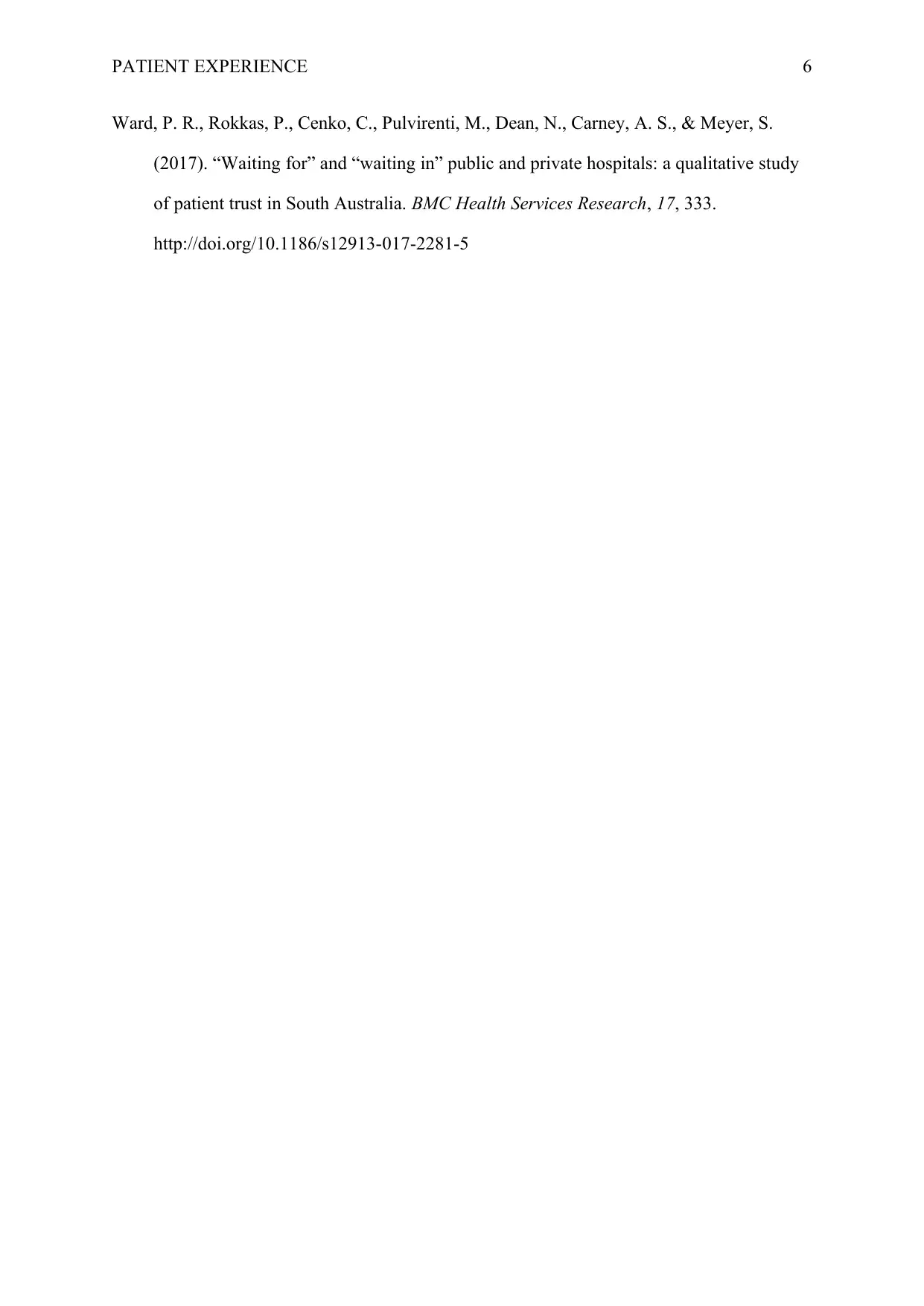
PATIENT EXPERIENCE 6
Ward, P. R., Rokkas, P., Cenko, C., Pulvirenti, M., Dean, N., Carney, A. S., & Meyer, S.
(2017). “Waiting for” and “waiting in” public and private hospitals: a qualitative study
of patient trust in South Australia. BMC Health Services Research, 17, 333.
http://doi.org/10.1186/s12913-017-2281-5
Ward, P. R., Rokkas, P., Cenko, C., Pulvirenti, M., Dean, N., Carney, A. S., & Meyer, S.
(2017). “Waiting for” and “waiting in” public and private hospitals: a qualitative study
of patient trust in South Australia. BMC Health Services Research, 17, 333.
http://doi.org/10.1186/s12913-017-2281-5
⊘ This is a preview!⊘
Do you want full access?
Subscribe today to unlock all pages.

Trusted by 1+ million students worldwide
1 out of 6
Related Documents
Your All-in-One AI-Powered Toolkit for Academic Success.
+13062052269
info@desklib.com
Available 24*7 on WhatsApp / Email
![[object Object]](/_next/static/media/star-bottom.7253800d.svg)
Unlock your academic potential
Copyright © 2020–2025 A2Z Services. All Rights Reserved. Developed and managed by ZUCOL.





